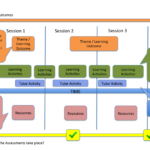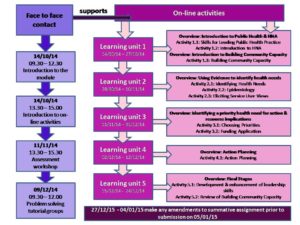The Science and Technology in Pedagogy (STRiPe) Research Group was set up to facilitate those working on teaching and learning activities related to science and technology to collaborate. Pedagogy is central to the success of the University, and having a cross-disciplinary and cross-university groups aims to help with this. STRiPe’s aims to take the work members are doing or planning to do with their students, and help with collaboration.
For information about the group, please see the page on the main University website.
Please click this link to access the blog maintained by School of Science and Technology.
In this associated blog post, Matthew Mccormack details the team approach to the redesign of the MA History, and how the use blogs aligned to evidence one of the key subject benchmark statements.
“Our blog assessment fits in with the module’s fortnightly structure. We alternate between ‘classroom’ and ‘online’, with the blog taking place alongside the online seminar: case studies have emphasised the importance of structuring blogging around the rhythm of classes. Every fortnight, the tutor posts up a primary source that relates to the previous class topic, and the students have 500 words per source to blog about it. After 5 fortnightly blogs, the students submit their work for assessment…One of the key ‘History’ skills highlighted in our subject benchmark is ‘an ability to read, analyse and reflect critically and contextually upon contemporary texts and other primary sources’ – so this is an example of how blending the method of delivery can enhance subject skills.”
At the recent Sharing Higher Education Design (S.H.E.D.) roadshow week in Science and Technology, the Learning Design team were introduced to a number of examples of good practice, including the hugely successful open educational resources (OERs) that have been published by staff in the School. These resources – some of which have had hits in the thousands – are publicly available, benefiting not just our students but learners around the world who are looking to further their understanding.
To find about more about these resources, visit the Learning and Teaching blog from the School.
Watch this space for more case studies from the S.H.E.D!
The Geography+ project aims to support the development of employability skills in students studying in levels 4 and 5 of the Geography programme. It is currently running as an extra-curricular ‘module’ led by Faith Tucker, with support from staff in the discipline and staff from the Changemaker hub.
For more detail about Geography+, have a look at the overview:
Bob has always taught his module using a traditional lecture-seminar format. He wants to bring in some new ideas, but doesn’t have much time to read up on pedagogic research. In the CAIeRO, he is teamed up with Joe and Laura. Joe is a new member of staff from a distance learning institution, who uses a lot of open educational resources to support his students in independent study. Laura leads another module on the programme, where she has been trialling peer teaching and problem based approaches. They spend some time discussing, sharing and planning. At the end of the session Bob’s storyboard for the module looks very different…*
In the context of CAIeRO, a ‘storyboard’ is a visual plan of your module from beginning to end. Once you have the blueprint of the module agreed, the next step is to figure out how to deliver that in practice. This is sometimes the most challenging part of the CAIeRO process, but it can also be where the magic happens – where a new vision for the module starts to become a reality.
The main aims of the storyboarding task are around sequencing, alignment and coherence. These can be achieved through mapping out the themes, learning activities and assessment items – what students need to know, how they will learn it, and how they will show that they have learned it (that constructive alignment idea again!). The idea is to create a logical sequence of activity, or learning journey, that allows the learner to build knowledge, skills and understanding so that these can be demonstrated through assessment. We’ll then go on to consider in detail how that learning might happen, and what kinds of activities can be put in place to support it.
 You will be asked to note down all of the broad themes that students on the module will need to learn about – the big concepts, the core skills, everything they’ll need to learn to reach the outcomes you’ve written – and to put them in some sort of sequence. This is a fun activity involving lots of post-it notes and flip chart paper, allowing things to be moved around and re-arranged as needed. The trick with storyboarding is to approach it from the perspective of the learner. Resist the temptation to replicate the way you deliver the module now – in week 1 I do this, in week 2 I do this… Instead, ask yourself: if I were a student coming to this for the first time, what would I need to learn first?
You will be asked to note down all of the broad themes that students on the module will need to learn about – the big concepts, the core skills, everything they’ll need to learn to reach the outcomes you’ve written – and to put them in some sort of sequence. This is a fun activity involving lots of post-it notes and flip chart paper, allowing things to be moved around and re-arranged as needed. The trick with storyboarding is to approach it from the perspective of the learner. Resist the temptation to replicate the way you deliver the module now – in week 1 I do this, in week 2 I do this… Instead, ask yourself: if I were a student coming to this for the first time, what would I need to learn first?
Start adding your post-its to the timeline – they need to learn about this, they need to learn how to do that – start with broad headings, and then break these down in to more detailed subheadings (these will be your learning activities). While you’re doing this, it’s also helpful to note down any relevant learning resources you have created or found (texts, videos, even expert speakers!). We’ll need these in the next section of the workshop. You might find you have more learning activities specified for introductory level 4 modules, where students might benefit from having more structure, and less for modules that are more student-led or involve more independent study. That’s fine, but if you’re unsure, you can do a quick ‘sense check’ back to your look and feel cards. Did you specify how much guidance you thought was appropriate? Are you sticking to that, or has your thinking changed?
Once you have a rough sequence for the learning activities, place your summative assessment activities on the timeline (usually using a different colour post-it). Here are some more ‘sense checks’. Are you covering all of the knowledge and skills needed for that assessment before it happens? If not, you need to move things around – or reconsider what’s being assessed at that point. Don’t worry if your blueprint changes as a result of storyboarding. CAIeRO is a dynamic process and nothing is set in stone! You should also check at this point that your learning activities plan includes opportunities to learn the skills required for the assessment, and to try these out formatively.
At this point you should be starting to get a sense of how the workload looks. Some areas of learning will be bigger than others. Some will cross over, and you may need to move things around. At this point there are two ‘sense checks’ to do. The first is around workload for the learner. Can you space out the activities evenly so that the workload is balanced? Do you know what’s happening in other modules that run alongside this? Think about how the student will experience the plan you are putting in place. This leads in to the second sense check: Where on the timeline will the students most need access to you?There is no right answer to this question; it will vary according to the subject, level and cohort, and you will also have to consider the constraints of your own workload, timetabling and so on. The important thing is to plan contact time that will have the most impact for learning. You might have one aspect of the module that students find particularly difficult, and choose to spend a substantial amount of contact time at that point to make sure students can progress. You might have the first module in the first year of a programme, and decide that weekly clarification sessions are important to make sure students are on track. You might have a distance cohort on different time zones, and decide that the best support you can provide is in frequent monitoring of discussions or online ‘office hours’ sessions. Whatever you decide, the CAIeRO process will help you work through the options – and the final storyboard can be digitised as a useful visual to help students understand your chosen approach.
If you’re doing a standard two day CAIeRO, ideally you will have a (mostly) completed storyboard for your module by the end of day 1. It’s a good idea to pause and reflect at this point, but it’s also important not to lose momentum. Once your outline is finalised, the next step is to start creating the learning activities.
This is one in a series of posts about the CAIeRO process. To see the full list, go the original post: De-mystifying the CAIeRO.
Need a CAIeRO? Email the Learning Design team at LD@northampton.ac.uk.
*All characters are fictional representations. ‘Bob’ and ‘Laura’ were inspired by Alex Bruton’s post on the Flipped Academic – worth a read if you have a little more time to spare…
Leading Public Health Practice (NURM009) includes learning and teaching activities that are predominantly facilitated via online learning. It was felt that a clear strategy was needed whereby students would be able to identify clearly how the activities and associated feedback can contribute to their summative assignment.
Students work sequentially through five learning units, each of which contains a brief overview of theoretical concepts and supported with structured on-line activities. Each learning unit concludes with a summary identifying how learning from each on-line activity can be utilised within their summative assignment.
For more information about this assessment, please contact Sue Everett, Senior Lecturer—Advanced Practitioner (Sue.Everett@northampton.ac.uk)
This case study is taken from the Institute of Learning and Teaching’s 2015 publication ‘Outside the Box Assessment and Feedback Practices’, available from the University’s Assessment and Feedback portal.
Within the School of Health we have a fundamental role in preparing and supporting people to work with the public, patients, carers and service users. We feel it is only right that these people should be involved in as many aspects of this as possible. We believe patients/service users and carers should be part of providing feedback on health and social care undergraduate students’ values and behaviours.
This is reinforced by the UK Government, who promote the idea that patients should contribute to the assessment of pre-registration student nurses. The Nursing and Midwifery Council promotes the idea that patients should contribute to the assessment of preregistration student nurses. With a strong emphasis currently on nursing becoming a more compassionate profession, the Francis report (2013) has highlighted a need to recruit, educate and assess nursing students with regard to their attitude, values, and beliefs in relation to providing care.
Who better to ask than the patients/service users and carers?
The following process was piloted and then implemented within all undergraduate nursing, midwifery and podiatry students from March 2014.
- Undergraduate students are introduced to service user and carer involvement and the role of the service user/carer in student assessment in first module of their education programme.
- Service user and carer feedback tools are available and are given to the Mentor by the student on placement.
- The Mentor/Assessor follows a four step process.
- Students’ practice learning documents have specific area for discussion with Mentor and recording Service user/carer feedback.
An e-learning activity was developed to support Mentors in this process. This is now an Open Education Resource available from http://find.jorum.ac.uk/resources/18963. Patient information posters were made available in practice areas and on digital display within patient areas in hospitals.
For more information about this assessment, please contact Linda Lilley, Senior Lecturer in Practice Development (Linda.Lilley@northampton.ac.uk)
This case study is taken from the Institute of Learning and Teaching’s 2015 publication ‘Outside the Box Assessment and Feedback Practices’, available from the University’s Assessment and Feedback portal.
We use ‘concept maps’ as an assessment tool within the Volunteering module (SWK1003). Students visualise the sub-concepts that make up a main concept. They can draw this out using whatever form or tool they want. It requires minimal grammatical competence but needs to show good conceptual understanding. The results were outstanding.
For more information about this assessment, please contact Mark Allenby, Senior Lecturer in Social Work (Mark.Allenby@northampton.ac.uk) or Victoria Boulton, Teaching Research Assistant (Victoria.Boulton@northampton.ac.uk).
This case study is taken from the Institute of Learning and Teaching’s 2015 publication ‘Outside the Box Assessment and Feedback Practices’, available from the University’s Assessment and Feedback portal.
Facilitation, Assessment and Quality Assurance in Work Based Learning (MIDM006) has two items of assessment, one of which is an action learning group presentation which is self, peer and tutor assessed. This is followed by a moderation discussion that supports students using and understanding the use of grade criteria and giving verbal and written constructive feedback which is an essential part of their role in practice. This is an innovative approach to assessment that has previously been presented at an HEA workshop.
This approach is also used in Quality Enhancement in Interprofessional Work Based Learning (MIDM007). Both these modules make up the MSc Practice Education. We can have big discrepancy between self, peer and tutor grades and discussion can be quite lively. It is stipulated that the tutor has overall responsibility for the final agreed grade from a quality assurance perspective. We have been persuaded to move but have never moved out of the grade band and we do have discussion about this when we are grading ourselves. We have a normal distribution of grades and we have referred students however we have never had students refer themselves or their peers.
As this is a group project we allocate all group members with the same grade however every group has opportunity to speak to the tutors if they feel strongly that someone has not properly contributed to the activity, there must be unanimous agreement from all other group members about this. On one occasion a group felt strongly that one member had not contributed and her grade was altered to reflect this.As well as the action learning students submit a 4,000 word critical reflective account and students are required to pass both items of assessment for both modules.
For more information about this assessment, please contact Ali Ewing, Principal Lecturer Learning and Teaching (Ali.Ewing@northampton.ac.uk) or Sue Everett, Senior Lecturer—Advanced Practitioner (Sue.Everett@northampton.ac.uk).
This case study is taken from the Institute of Learning and Teaching’s 2015 publication ‘Outside the Box Assessment and Feedback Practices’, available from the University’s Assessment and Feedback portal.
Students take individual readiness assurance tests, then take the same test as a group. The group use the trademarked Instant Feedback Assessment Technique, essentially scratchcards, so they immediately know if they got the right answer. By assessing the students’ readiness to move on to application exercises we should be able to address gaps in learning early on.
‘Getting Started with TBL’ by Larry K. Michaelson is available here: https://www.med.illinois.edu/FacultyDev/Classroom/InteractiveMethods/Michaelson.pdf
For more information about this assessment, please contact Nick Cartwright, Senior Lecturer in International Commercial Law (Nick.Cartwright@northampton.ac.uk)
This case study is taken from the Institute of Learning and Teaching’s 2015 publication ‘Outside the Box Assessment and Feedback Practices’, available from the University’s Assessment and Feedback portal.
Recent Posts
- Getting started with AI: A guide to using the Jisc Discovery Tool’s new AI question set.
- Blackboard Upgrade – April 2024
- Exploring the Role of GenAI Text to Enhance Academic Writing: A Conversation with Learning Development Tutor Anne-Marie Langford.
- Blackboard Upgrade – March 2024
- Case study: GenAI in BA Fashion, Textiles, Footwear & Accesories 2024
- Exploring the Educational Potential of Generative Artificial Intelligence: Insights from David Meechan
- Exploring the Fusion of Fashion and Artificial Intelligence: Jane Mills’ Pioneering Journey – Vulcan Sessions Talk.
- Artificial Intelligence Meets Drama: Matt Bond’s PlayAI Project Chronicles the Journey
- Blackboard Upgrade – February 2024
- Game On: Winter Game Jam 2024
Tags
ABL Practitioner Stories Academic Skills Accessibility Active Blended Learning (ABL) ADE AI Artificial Intelligence Assessment Design Assessment Tools Blackboard Blackboard Learn Blackboard Upgrade Blended Learning Blogs CAIeRO Collaborate Collaboration Distance Learning Feedback FHES Flipped Learning iNorthampton iPad Kaltura Learner Experience MALT Mobile Newsletter NILE NILE Ultra Outside the box Panopto Presentations Quality Reflection SHED Submitting and Grading Electronically (SaGE) Turnitin Ultra Ultra Upgrade Update Updates Video Waterside XerteArchives
Site Admin




